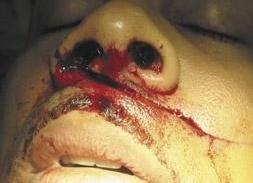
3 minute read
Unknown Danger
By Lt. Gary Horsey, USS Theodore Roosevelt (CVN-71)
e just had a wonderful port visit in Fort Lauderdale, Florida,” said the ship’s CO over the 1MC. “Keep your head on a swivel.” “W
Advertisement
Part two of COMPTUEX was beginning, and we were ready to “git-’er-done.” An AS2 supervisor with 10 years of superb Navy service was leading his Sailors in the daily production efforts in AIMD’s IM-4 supportequipment division. As supervisor, he assigned an AS3 to work on a recently inducted liquid-coolant-filtration unit (LCFU). One of the squadrons had turned in the unit when it stopped working, with this note attached: “The red light comes on and won’t go out, and the unit doesn’t work now.” The AS2 assigned an AS3 to the task—a shipmate who just had returned from several months TAD as a master-at-arms. The AS2 assisted him, along with one other AS3.
They gathered all the required pubs and tools and even signed in to work on the computer. After a good visual check of the LCFU, they fired up the unit, and the fault indicator (red light) immediately illuminated, just like the gripe said. As required by the maintenance pub (NAVAIR AG-521AC-574-100, Section 4, page 11), the filters had to be changed and any lost coolant had to be replenished. The two filters were replaced with no problem. One AS3 then went to the hazmat locker to get some coolant to refill the unit.
Meanwhile, the AS2, with the other AS3 watching, continued with the final maintenance procedures. He prepared to remove the LCFU make-up reservoir lid to facilitate adding the coolant. First, he loosened the bleed valve, which is part of the lid, to bleed off the pressure in the LCFU. With the other AS3 watching, the AS2 again carefully looked over the LCFU before getting any tools to remove the lid. Satisfied, he grabbed the right tools and started loosening the two bolts on the ring clamp that hold the lid in place.
Before the AS2 had completed the last few turns to remove one bolt, the lid exploded off the LCFU with a loud pop. The lid hit the AS2 in the face. He immediately grabbed his mouth and doubled over. That was the last position I recalled seeing him in before he was rushed to medical. He received more than 40 stitches (covering 6 inches of his face), had three hours of

microsurgery, and then was put on a COD flight off the ship for further surgery to repair a fractured skull.
Investigators found none of the regular ingredients for mishaps; the AS2 had received adequate training, and pre-operational checks of equipment had been done. Complacency, lack of communication, and the day-to-day operational environment did not lead to this disaster. The investigation team did find an obstructed bleed valve that prevented the complete release of pressure.
Maintenance Operational Risk Management Note:
The AS2’s overall situational awareness was lower than it should have been. Without considering the possibility that there could be more than the normal 9 to 12 psi in the cylinder, he loosened the retaining ring clamp, while leaning directly over the LCFU, which placed his face over the lid. The resulting situation could have been fatal.
Several lessons were re-learned that day: • Wear PPE whenever working with any pressurized equipment, regardless of the unit’s psi rating. • Always stand to the side of a pressurized opening when performing maintenance on any pressurized equipment.
Proper use of ORM can help identify these hazards before they become a mishap, but we must consider the risks and controls before we perform any maintenance action.
Lt. Horsey is the IM-4 Division Officer.










